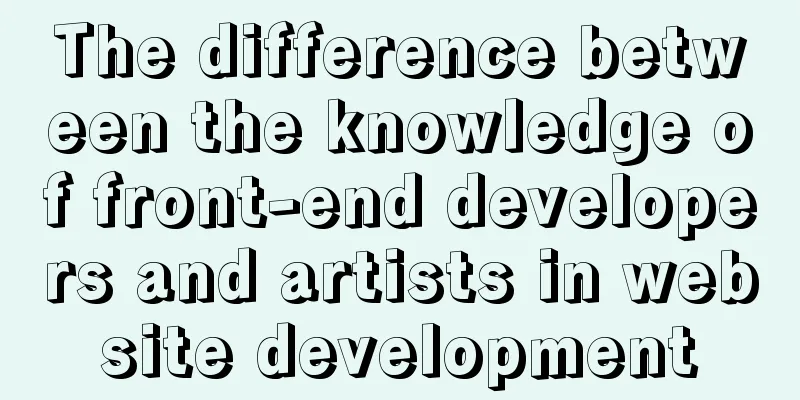The difference between the knowledge of front-end developers and artists in website development

|
Abstract: Many companies, even most companies whose main business is Internet websites, confuse the concept of "artist". Usually these companies refer to those who design and produce web pages as "artists". A mature Internet company will have a more detailed talent plan for the website, such as the UED team (abbreviation of User Experience Design in English), which is divided into positions such as "interaction design", "visual design", "front-end development", "user research", and "copywriting". Today, mainly for this topic, I would like to share with you the functional differences between "artist" and "front-end"... 1. What is art? Art Engineer: It means Art Engineer, most of them are graduates of art design major in art colleges. According to the nature of the work, art design is generally divided into three categories: graphic design, three-dimensional design, and web design. Graphic design is done by an artist using Fireworks or Photoshop to design the graphic appearance. Three-dimensional art design is done by artists using tools such as 3DMAX to design three-dimensional character models, prop models, environmental scene models, packaging designs, etc. Web design is the process of using web editing software such as Dreamwerver to turn the designed graphic renderings into HTML static web page files. Here the artist is required to use CSS and DIV technology, which is the so-called cutting picture. To be more specific, web designers generally need to be proficient in PHOTOSHOP/CSS/HTML/JAVASCRIPT and other Internet languages or tools to process web page frameworks, colors, tones, creativity, etc. The web page design mentioned here is actually a product of the Web 1.0 era. At that time, most websites were static HTML pages, and users mainly used the website for browsing. After 2005, the Internet entered the Web 2.0 era, and various Web Apps with similar desktop applications emerged in large numbers. Such as Gmail Google Reader and so on. The front-end and interaction of the website have undergone earth-shaking changes. Web pages no longer just present single text and pictures. Various rich media make the content of the web pages more vivid, and the software-based interactive form also provides users with a better user experience. These are all achieved through the close collaboration of multiple front-end technologies. As a result, the position of "front-end development engineer" came into being! 2. What is a front-end development engineer? Front-end development engineer is the abbreviation of Web front-end development engineer. It is an emerging profession that has only really begun to receive attention in the past five years. Web front-end development technology is a process that starts easy and then becomes difficult. It mainly includes three elements: HTML, CSS and JavaScript. This requires front-end development engineers to not only master basic Web front-end development technology, website performance optimization, SEO and basic knowledge of the server side, but also learn to use various tools for auxiliary development as well as theoretical knowledge, including code maintainability, component usability, layered semantic templates and browser hierarchical support. A front-end development engineer, to put it simply, turns the designer's artwork into an HTML page that is actually presented in the browser for users to click and interact with. This job can be as simple as exporting a page directly with a few clicks of the mouse using Photoshop Fireworks; or it can be as complex as considering the semantics of each tag, overall performance, browser compatibility, user interaction, search engine optimization, etc. The basic skill requirements are proficiency in the use of graphic image processing tools, proficiency in HTML/CSS/JavaScript front-end languages, and preferably knowledge of a server-side language such as PHP, etc. It is very easy to get started in the front-end development industry. You can buy a book on HTML+CSS and teach yourself for a week or two, then you may be able to find a job in "web page production". However, it is more difficult to truly become an excellent front-end engineer, because the front-end technologies are easy to get started but difficult to master. It is easy for most people to get started but difficult to master. In addition, many companies do not pay enough attention to it, which leads to large differences in the level of front-end engineers and generally low salaries. As a result, more people are unwilling to learn front-end development that requires multiple technologies, because they can spend less energy learning a back-end language. 3. Knowledge that an excellent front-end developer needs to master <br />To do front-end development, the first and most basic thing is to master HTML+CSS. With these two most basic knowledge, you can cut out a page easily. But this is not enough, we must also be compatible with a variety of browsers. Although some companies only require compatibility with IE6/7/8+Firefox, as a good front-end developer, you must set higher requirements for yourself. In addition to being compatible with several commonly used browsers, it is also best to be compatible with Chrome, Opera, Safari and other browsers. In order to be compatible with so many browsers, you must master the knowledge of CSS HACK so that you can use HACK technology to distinguish and be compatible with various versions of browsers. But I believe that since it is compatible with Firefox, it is not difficult to be compatible with these. After being able to write elegant HTML Code, we also need to comply with W3C standards and semantic specifications as much as possible. Although there is no strict requirement in this regard, it is necessary to do these two things well. A good website front-end engineer needs to consider the semantics of every HTML tag. Reasonable use of Hx tags, ul ol dl tags, etc. Make your pages well-structured and readable even with CSS disabled. We know that among domestic Internet users, more people use IE browser. However, from the perspective of domestic or global Internet users, some customers do not use IE to browse the Internet. They use other browsing tools such as Netscape, Mozilla, FireFox, Opera, etc. If your website does not comply with W3C standards, users using other browsers will not be able to see your website. Then some customers will not be able to see your business or products. Although this part of customers is relatively small, it is still a part of customers after all. Losing any potential customers is a loss for the company. There are many benefits to complying with W3C, such as: faster file downloads and page displays; content can be accessed by more users (including the blind, visually impaired, color-blind, and other disabled people); content can be accessed by a wider range of devices (including screen readers, handheld devices, search robots, printers, refrigerators, etc.); users can customize their own presentation interface through style selection; all pages can provide print-friendly versions, etc. After fully mastering the knowledge of HTML+CSS, the next most difficult task is JavaScript. JS is one of the essential skills for the front-end and it is also the most difficult part. The reason why it is put here is to allow beginners to have a gradual step. It would be difficult to digest too many things at the same time. It would be less stressful if you learn them step by step. Among these, front-end development needs to master basic DOM operations, understand AJAX, and be able to write efficient OOP code to reduce maintenance costs. There are more and more JS frameworks now, such as Jquery, Prototype, Yui, Dojo and so on. Front-end development should be based on various needs, and different development should be carried out. The appropriate framework should be selected to achieve the highest code efficiency, the best user experience, the smallest code download volume, and the maximum code reuse in a single or even more product lines. The above is the necessary knowledge for a front-end development engineer. Next, let’s talk about the front-end expansion skills. 1. Selectively master Photoshop or Fireworks . The level of learning can be determined according to your own needs. If you want to make a living with front-end development in the future, you won't need front-end development to do design drafts when you work in a big company. You just need to be able to cut pictures into layers. Of course, if you are interested in design, it is also a good thing to be good at using PS. 2. Understand a back-end language <br />You can learn about back-end languages such as PHP+Mysql or JSP. The particularity of our profession determines that we need to communicate frequently with back-end workers. Mastering some knowledge in this area will help to communicate more effectively. Improve the image of the front-end in the entire team, and thereby improve your own treatment. In addition, if you learn this part well, you can be more secure when a company asks you to build a website. As for whether to learn PHP or JSP, it depends on your own preferences. I personally feel that PHP is very good. Many open source programs are in PHP. Learning it will help you build your own website. In addition, WordPress is a very interesting thing. 3. SEO+UE (User Experience) User experience is king, and SEO is king in attracting users. UE is actually an indispensable part of front-end development. If you can master this, you can be promoted to the position of product manager or department manager; if you can do this well, you can win the satisfaction of your customers. Besides, this thing is not difficult to learn, just pay more attention to observe life. Why not? 4. Front-end performance optimization <br />Mastering this skill can improve the speed of the website and save money for the company. If you have time, you can look up some website page optimization rules, such as: minimize the number of HTTP requests, CSS Sprites image integration technology, merge CSS and JS, use CDN technology, reduce the number of DNS lookups, avoid redirects, etc. After reading this, do you have a deeper understanding of the term "front end"? Is it very different from traditional "art"? I have done some surveys. Some front-end developers don't care what others call them, but some are very disgusted by this term. Because in today's WEB2.0 era, the title of "artist" seems more old-fashioned and out of date, because now the front-end of the website requires more professional development skills. So whether it is front-end development or visual design, I don’t like this title. What I shared here today is just a superficial understanding of "front-end development". I will have the opportunity to discuss this theory with you in more depth. |
<<: New usage of watch and watchEffect in Vue 3
Recommend
Summarize some general principles of web design and production
<br />Related articles: 9 practical suggesti...
Detailed explanation of the API in Vue.js that is easy to overlook
Table of contents nextTick v-model syntax sugar ....
A brief discussion on HTML ordered lists, unordered lists and definition lists
Ordered List XML/HTML CodeCopy content to clipboa...
MySQL's conceptual understanding of various locks
Optimistic Locking Optimistic locking is mostly i...
How to set up PostgreSQL startup on Ubuntu 16.04
Since PostgreSQL is compiled and installed, you n...
How to remotely connect to MySQL database with Navicat Premium
The party that creates a new connection is equiva...
Detailed explanation of how a SQL statement is executed in MySQL
Overview I have recently started learning MySQL r...
Summary of various uses of JSON.stringify
Preface Anyone who has used json should know that...
Detailed explanation of four types of MySQL connections and multi-table queries
Table of contents MySQL inner join, left join, ri...
Webpack loads css files and its configuration method
webpack loads css files and its configuration Aft...
Detailed explanation of Truncate usage in MYSQL
This article guide: There are two ways to delete ...
My personal summary of mysql 5.7 database installation steps
1.mysql-5.7.19-winx64.zip (this is the free insta...
How to use watch listeners in Vue2 and Vue3
watch : listen for data changes (change events of...
Who is a User Experience Designer?
Scary, isn't it! Translation in the picture: ...
MySQL 5.7.13 source code compilation, installation and configuration method graphic tutorial
Installation environment: CentOS7 64-bit MINI ver...









